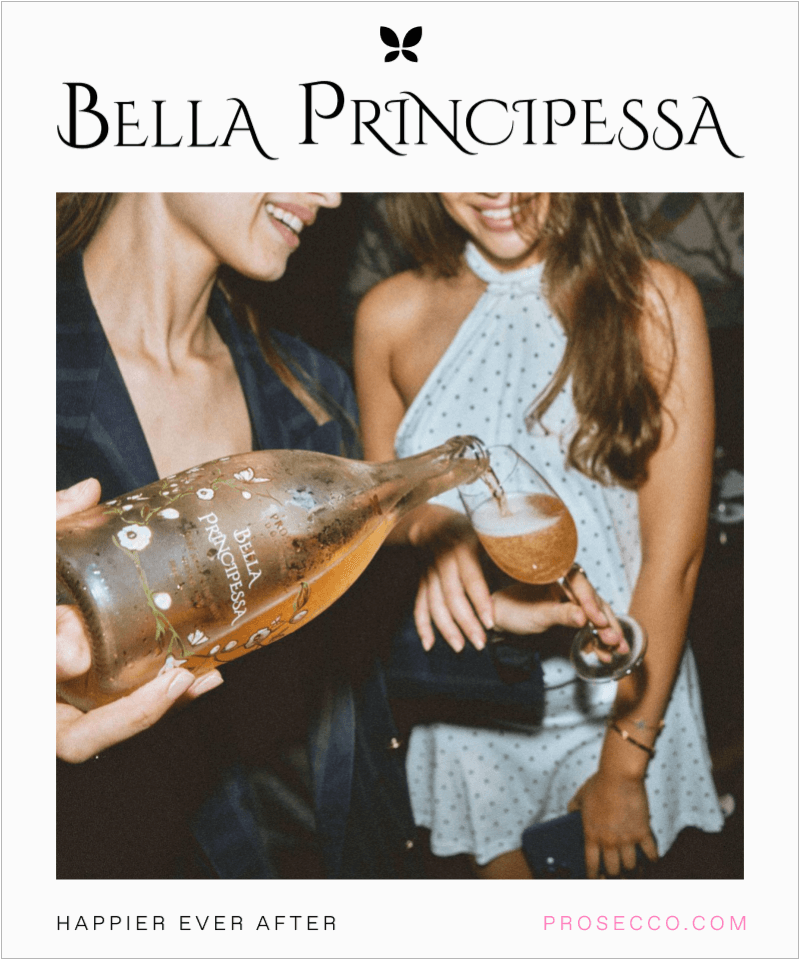“How is Prosecco made?” This question opens the door to exploring the intricacies of Prosecco production, a fascinating process steeped in tradition and modern techniques, much like the cherished Bella Principessa and Signorina Prosecco brands.
Prosecco is made using the Charmat method, where the secondary fermentation occurs in stainless steel tanks before bottling.
Prosecco, primarily known for its refreshing sparkle, is a sparkling wine hailing from Italy’s Veneto and Friuli-Venezia Giulia regions.
The heart of its production lies in the Glera grape, a variety that defines Prosecco’s distinctive character. Transforming these grapes into the sparkling delight we know and love involves several stages, each contributing to the wine’s final taste and quality.
The first stage involves harvesting the Glera grapes, typically done by hand due to the steep hillside vineyards where these grapes flourish. This manual approach, reminiscent of the careful selection of grapes for Bella Principessa Prosecco, ensures the highest fruit quality.
Once harvested, the grapes undergo primary fermentation, where they are crushed, and the juice is fermented in stainless steel tanks. This step is crucial in developing the base wine, which will later be transformed into sparkling Prosecco.
The next, and perhaps most significant stage, is the secondary fermentation. Prosecco is unique in its use of the Charmat method, also known as the Martinotti Method.
This method, which differs from the traditional method used in Champagne production, involves a secondary fermentation in large, pressurized stainless steel tanks rather than individual bottles.
This secondary fermentation is where the magic happens – adding yeast and sugar to the base wine triggers a fermentation process that generates carbon dioxide, creating the wine’s signature bubbles.
The Charmat method is praised for preserving the freshness and aromatic quality of the grapes, producing a sparkling wine that is lighter and fruitier than its counterparts made using the traditional method. Brands like Signorina Prosecco excel in capturing these fresh, vibrant qualities in their wines.
Once secondary fermentation is complete, the wine is cooled, clarified, and filtered. This step is crucial in achieving the clear, sparkling quality of Prosecco. The wine is then bottled under pressure to maintain its effervescence.
Quality and classification play a vital role in the Prosecco world. Proseccos are categorized as DOC (Denominazione di Origine Controllata) or DOCG (Denominazione di Origine Controllata e Garantita), with DOCG representing higher quality standards.
These classifications dictate the production methods, grape varieties, and geographic areas where the grapes are grown. For instance, Bella Principessa Prosecco, with its commitment to quality, is a testament to the high standards set by these classifications.
In terms of sweetness, Proseccos are labeled based on their residual sugar content. They range from Brut (up to 12 grams per liter), Extra Dry (12–17 g/L), to Dry (17–32 g/L). This range offers consumers a variety of taste profiles, from the drier, more subtle Brut to the sweeter and more pronounced Dry style.
A point of distinction for Prosecco is its shelf life. Unlike many other sparkling wines, Prosecco is designed to be enjoyed young. The typical recommendation is to consume it within three to five years of its vintage, although high-quality Proseccos can be aged up to seven years.
This aspect of Prosecco aligns with the ethos of brands like Signorina Prosecco, which emphasizes the enjoyment of the wine in its freshest form.
Another interesting variation within the Prosecco world is the less common Tranquillo style, a still wine with no bubbles, accounting for about 5% of Prosecco’s production. This style, though rare, offers a different perspective on the Glera grape, showcasing its versatility.
In conclusion, the production of Prosecco is a blend of tradition, innovation, and strict quality standards. Every step contributes to the wine’s signature sparkle and flavor profile, from the meticulous grape selection to the precise Charmat method.
Brands like Bella Principessa Prosecco DOCG and Signorina Prosecco Doc embody this dedication to quality, presenting consumers with sparkling wines that capture the essence of their Italian heritage.











